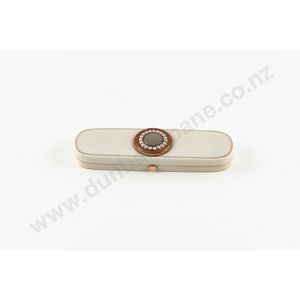George III Ivory Patch Box with Carnelian and Pearls
George III ivory patch box, gold mounted rectangular box set centrally with carnelian seed pearl and braid roundel 9 cm length
You must be a subscriber, and be logged in to view price and dealer details.
Subscribe Now to view actual auction price for this item
When you subscribe, you have the option of setting the currency in which to display prices to $Au, $US, $NZ or Stg.
This item has been sold, and the description, image and price are for reference purposes only.
- Ivory - Ivory is a hard white material that comes from the tusks of elephants, mammoth, walrus and boar, or from the teeth of hippopotamus and whales. The ivory from the African elephant is the most prized source of ivory. Although the mammoth is extinct, tusks are still being unearthed in Russia and offered for sale.
Ivory has been used since the earliest times as a material for sculpture of small items, both in Europe and the east, principally China and Japan.
In Asia ivory has been carved for netsuke, seals, okimono, card cases, fan supports, animals and other figures and even as carved tusks.
In the last 200 years in Europe ivory has been used to carve figures, for elaborate tankards, snuff boxes, cane handles, embroidery and sewing accessories, in jewellery and as inlay on furniture. Its more practical uses include being used for billiard balls, buttons, and a veneers on the top of piano keys.
The use and trade of elephant ivory have become controversial because they have contributed to Due to the decline in elephant populations because of the trade in ivory, the Asian elephant was placed on Appendix One of the Convention on International Trade in Endangered Species (CITES), in 1975, and in January 1990, the African elephant was similarly listed. Under Appendix One, international trade in Asian or African elephant ivory between member countries is forbidden. Unlike trade in elephant tusks, trade in mammoth tusks is legal.
Since the invention of plastics, there have been many attempts to create an artificial ivory - George Iii - George III (1738 - 1820) was King of Great Britain and Ireland from 1760 to 1820.
- Carnelian Glass - Carnelian glass is a type of glass that is colored red, orange, or brownish-red. It is made by adding iron oxide to the glass mixture. The color of carnelian glass can vary depending on the amount of iron oxide that is added, as well as the firing temperature. Carnelian glass is often used to make beads, jewellery, and other decorative items. It can also be used to make stained glass windows and other art objects. Carnelian glass is sometimes called "carnelian chalcedony" or "carnelian quartz."
Carnelian glass was first made in the Roman Empire. It was also made in ancient Egypt, Greece, and Mesopotamia. Carnelian glass was not made again until the Renaissance, when it became popular again. Today, carnelian glass is made in many countries around the world. - Roundel - A roundel is a circular disk, medallion or border on a plate or dish, on an object of furniture. A plate or dish will often have a central circular bordered decoration, termed a roundel. In furniture the word is often used instead of the word 'patera' to describe a turned circular decoration. In recent times use of the word has expanded to encompass any circular area on an object.
This item has been included into following indexes:
-
boxes, material or decoration
- gold boxes 94
- ivory boxes 89
- patch boxes 67
